18. Function and Use of Roman Medium-Sized Statuettes in the Northwestern Provinces
- Annemarie Kaufmann-Heinimann, Universität Basel
Abstract
When we think of figural bronzes from the northwestern provinces of the Roman world, a considerable number of small statuettes and some impressive fragments of life-size statues come to mind.1 Medium-sized statuettes, between approximately 40 and 100 centimeters (16 to 39 in.) high, however, are less well documented, as they seem to have had less chance of surviving either intact, as did small bronzes, or as fragments, as did large statues. It may be worthwhile, therefore, to examine some of these specimens more closely in order to see whether it is possible to gain more information about their use and function: Were they used as decorative elements in villa gardens, as votive objects, or even as the cult images of temples?2
Before looking at some objects and their original contexts, it is important to know more about the presumed Roman approach to questions of function, covering life-size statues as well. According to literary and epigraphical evidence, the Latin language did not distinguish between the types of use mentioned above.3 Every anthropomorphic image of a god could be called simulacrum or signum, but these terms were not restricted to one function: they could apply either to the cult statue—which was consecrated at the same time as the temple itself—or to other works of art displayed in the temple or elsewhere. Simulacra displayed in a sanctuary, however—with the exception of the cult statue itself—had the status of ornamenta. This means that they were not sacred but, being res profana, could be reused in other contexts if the need should arise. Votive objects, too, belonged to the category of ornamenta, independent of what they represented. This means that our ideas about neatly defined and mutually exclusive functions of statues and statuettes do not accord with the reality of the time. A vivid illustration of this fact is given, for instance, by Pliny the Younger in one of his letters (3.6): contrary to what we would expect, he did not keep his newly acquired medium-sized statuette of an old man made of Corinthian bronze as an embellishment of his own house but decided to offer it as a votive gift at the temple of Jupiter, having ordered a base for it mentioning his name and titles.4 In an archaeological context, we would certainly have classified such an object as a private decorative sculpture and not as a votive object. It is advisable to keep in mind this broader Roman approach when trying to improve our knowledge of possible functions.
One group of statuettes is best characterized as decorations for private houses and gardens, if we take into account the evidence provided by the Vesuvian cities. There are, on the one hand, all sorts of fountain decorations,5 and on the other hand a wide range of so-called silent servants and lamp-bearers, which can reach up to life-size.6 The most famous representative of the second group found north of the Alps is certainly the so-called Boy from Xanten, discovered in 1858 on the bank of the Rhine near Xanten.7 Another large statuette in the same category of bronzes serving a practical purpose was found in 1893, also on a riverbank, this time in northern France, at Pont-Sainte-Maxence near Senlis (Oise) (fig. 18.1); unfortunately, its present location is unknown.8 A closely related parallel to it came to light in 1875 on the Viminal Hill in Rome,9 and it is evident that these two tablet-bearing Hermaphrodites must have derived from the same prototype. The existing photos of the bronze from France do not allow a definite statement as to its style and place of manufacture; a Gallo-Roman origin, however, cannot be ruled out. The Boy from Xanten, on the other hand, was certainly manufactured in a Mediterranean workshop in Early Imperial times and most likely came to northern Germany in the possession of a high-ranking officer posted to the legionary camp of Xanten.
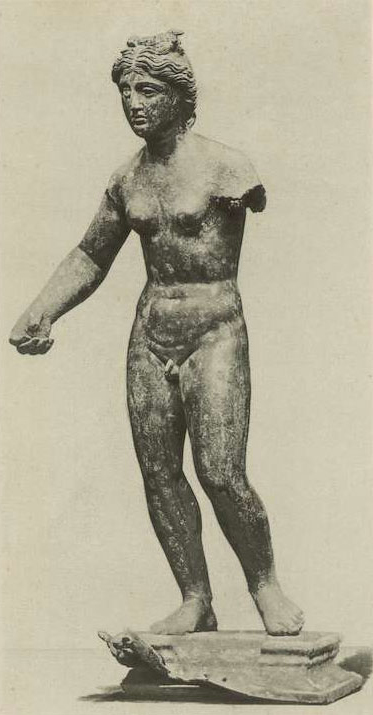
An impressive find was made in the Roman villa of Champigneulles near Nancy (Meurthe-et-Moselle, France), inhabited from the second century AD onward. The metal hoard stored in one of the cellars contained not only all sorts of bronze, iron, and lead fragments, but also one nearly intact statuette of Bacchus, whose only damage was the missing left arm, originally cast separately.10 According to the numismatic evidence and the traces of fire, the villa was destroyed around the middle of the fourth century AD, and it is most likely that at that time the invaders collected all sorts of metal items found in the house with the intention of recycling them later. The large statuette of Bacchus could originally have been used as a garden sculpture.
So far the evidence of the archaeological context or the specific type of a statuette has pointed to its possible use as a private decorative sculpture. There are, however, a great many medium-sized statuettes that are best understood as forming part of the furnishings of a sanctuary. Important information is given by an old find made within the sacred area of the vicus of Dalheim (Luxembourg), which was part of the civitas of the Treveri. The excavations undertaken in 1863 were incompletely documented, but they brought to light an octagonal sanctuary and, installed on the same axis, a small square building in which two large statuettes of Jupiter and Minerva were found (figs. 18.2–3).11 They testify to the very high standard of Gallo-Roman bronze-work of the late second century AD, although the artist did not fully master the complicated drapery of Minerva’s dress. John Scheid’s suggestion that the statuettes may have been the cult images of a temple dedicated to the Capitoline triad is tempting; in that case the statuette of Minerva, which is considerably smaller than the Jupiter, might have been a later replacement for the one originally belonging to the group.12 So far, however, no firm epigraphical evidence for the Capitoline triad has come to light at Dalheim.13 The survival of the two statuettes, virtually unharmed, in the middle of the vicus is quite exceptional, when we think of the devastating raids of Germanic tribes in the later third century AD. More often, deposits of statues are preserved at a certain distance from the places to which they originally belonged, as the following finds will show.
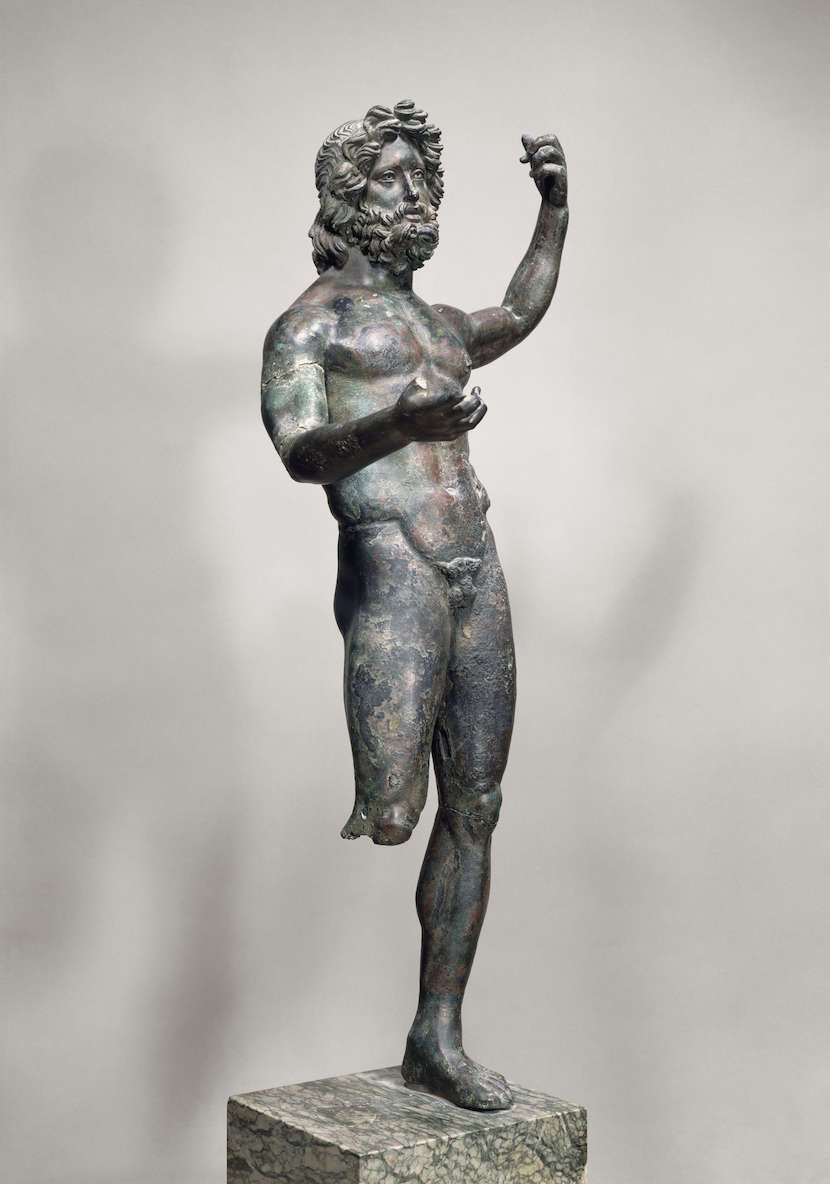
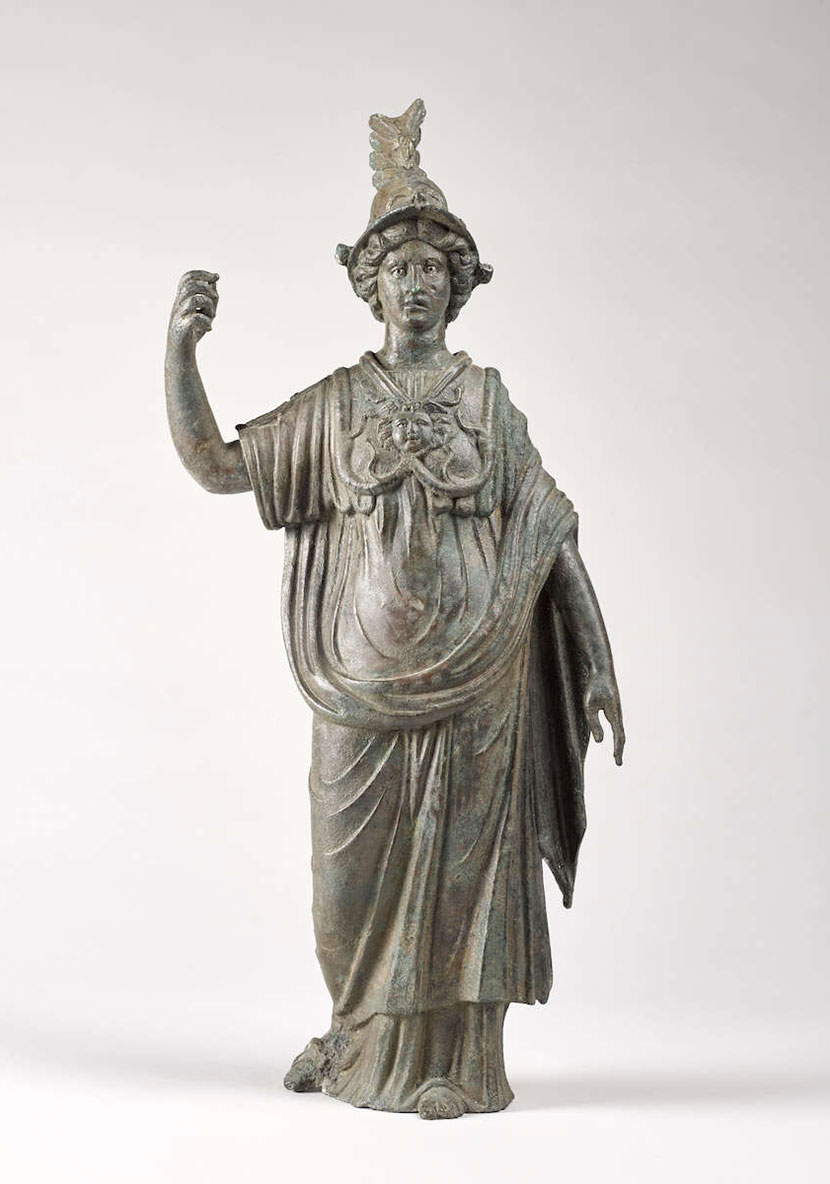
A few years ago, two statuettes of Mercury and his female counterpart—perhaps Rosmerta—were discovered in a forest near Turny (Yonne, France) (fig. 18.4).14 They had been deposited in a pit far from the nearest known Roman remains. This could hint at a reorganization of the mass of votive gifts put on display in a sanctuary by removing some of the older ones. Yet we cannot entirely rule out the possibility that the two statuettes have been put aside by a bronze-worker; but if such were the case we ought to wonder why no other bronze fragments were added, as was the case of Champigneulles. Mercury and Rosmerta were probably made in the same Gallo-Roman workshop active in the late second or early third century AD, taking into account the modeling of the bodies and the rather coarse facial features. A technical detail that we often notice in statuettes of this size is the missing cap-like top of Mercury’s skull. As the head was to be covered by the petasos, this part would be invisible later and therefore no metal was wasted on it.
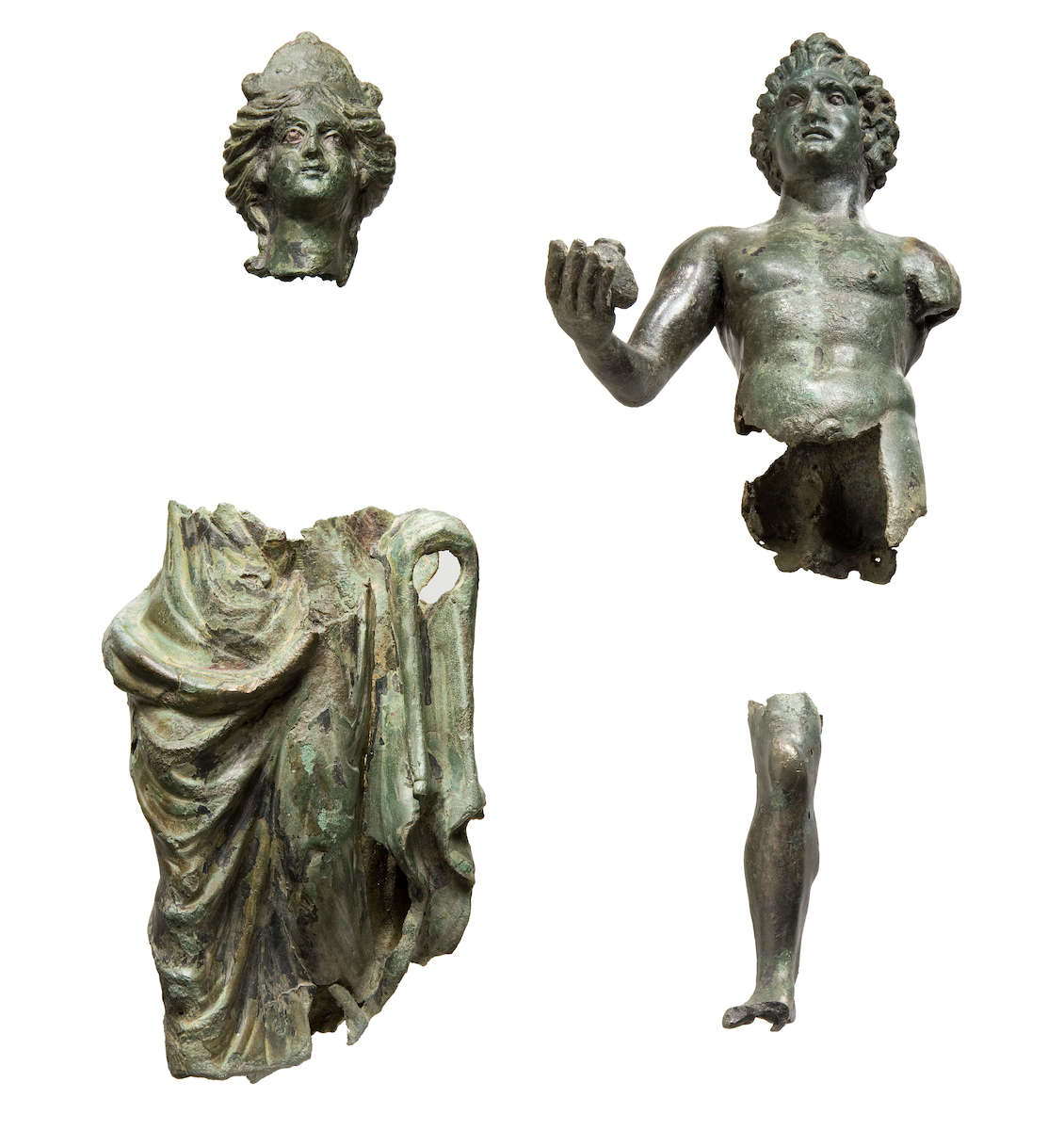
A similar scenario may account for a find made around 1910 in the north of France. Dredging the river Lys near Thiennes (Nord) brought up three medium-size bronze statuettes of Jupiter, Mars, and Mercury (figs. 18.5–7).15 We may only speculate about where they were originally stashed and what was the nature of that spot, as in Roman times they were certainly deposited on firm ground. Some scattered Roman potsherds were found in the vicinity, but no traces of a building are known so far. Without an autopsy it is difficult to say whether the bodies of all three statuettes are based on a single model, but it seems at least possible that they were made in the same workshop, if by different bronze-workers.16 As to their original function, Stéphanie Boucher suggested that they might have been standing in an extra shrine dedicated to that trias, despite the fact that there is hardly any epigraphical evidence of the three together.17 It is certainly safer to assume that they had been offered as votive gifts to a regional sanctuary, the location and divine patron of which are unknown.18 At a certain point they were put away, in the same way as has been suggested for the bronzes from Turny.
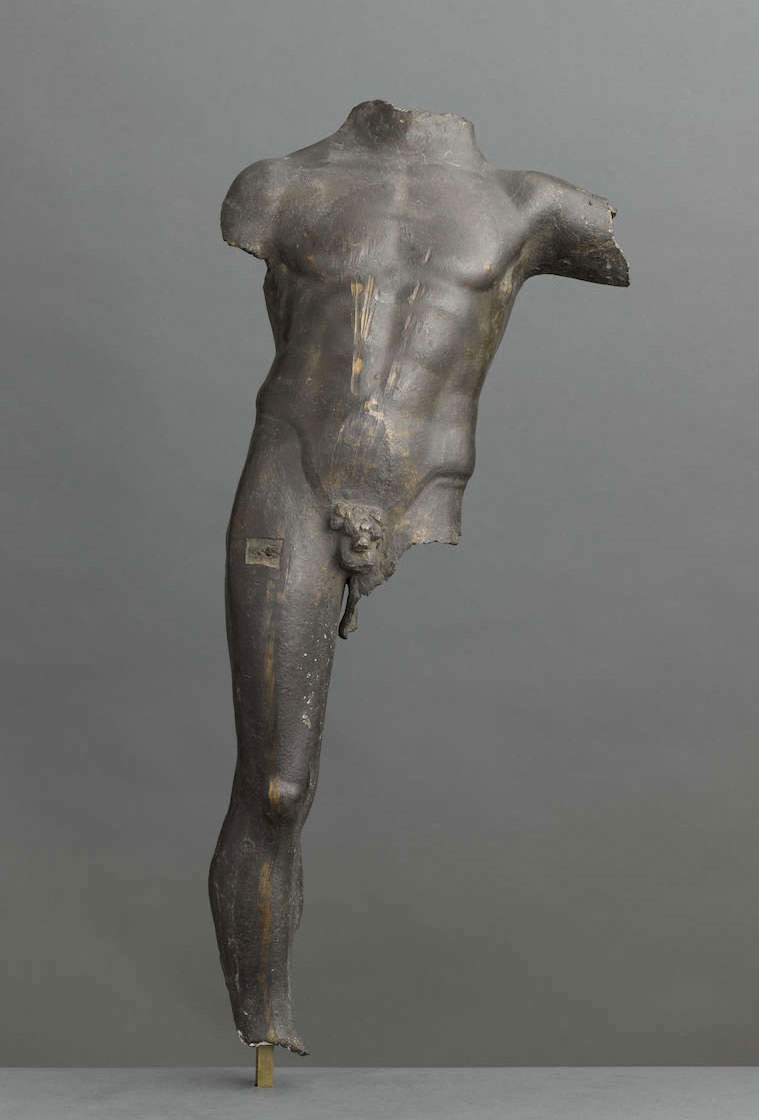
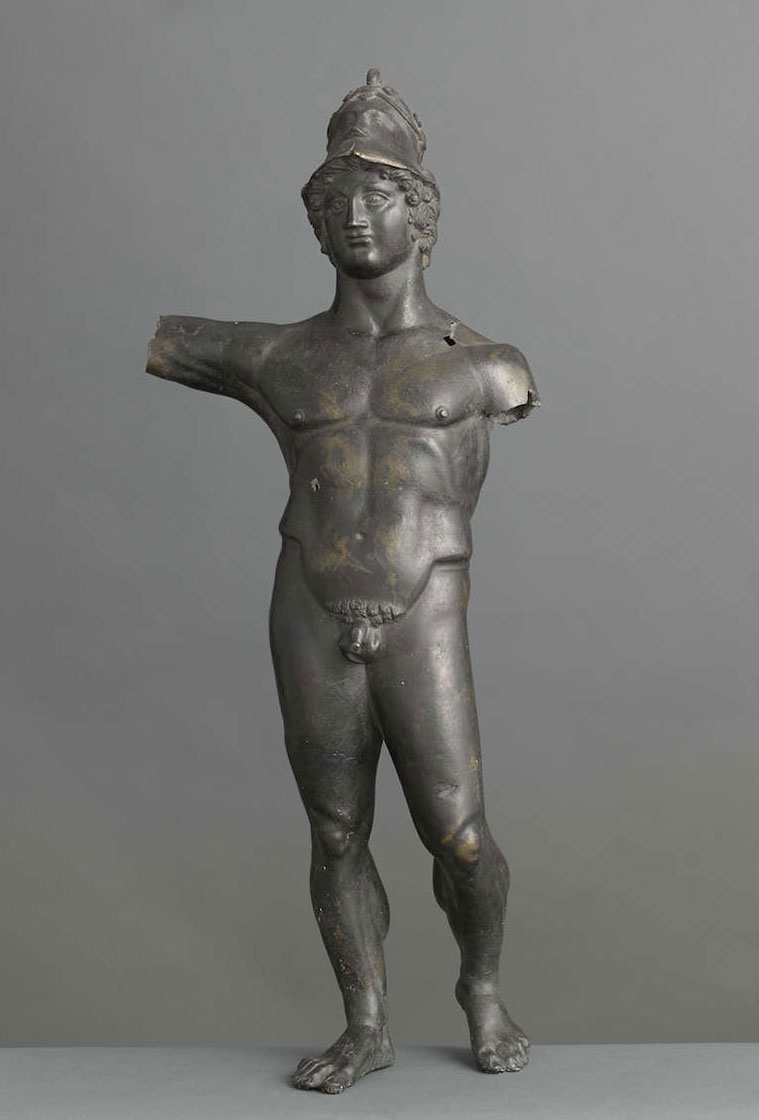
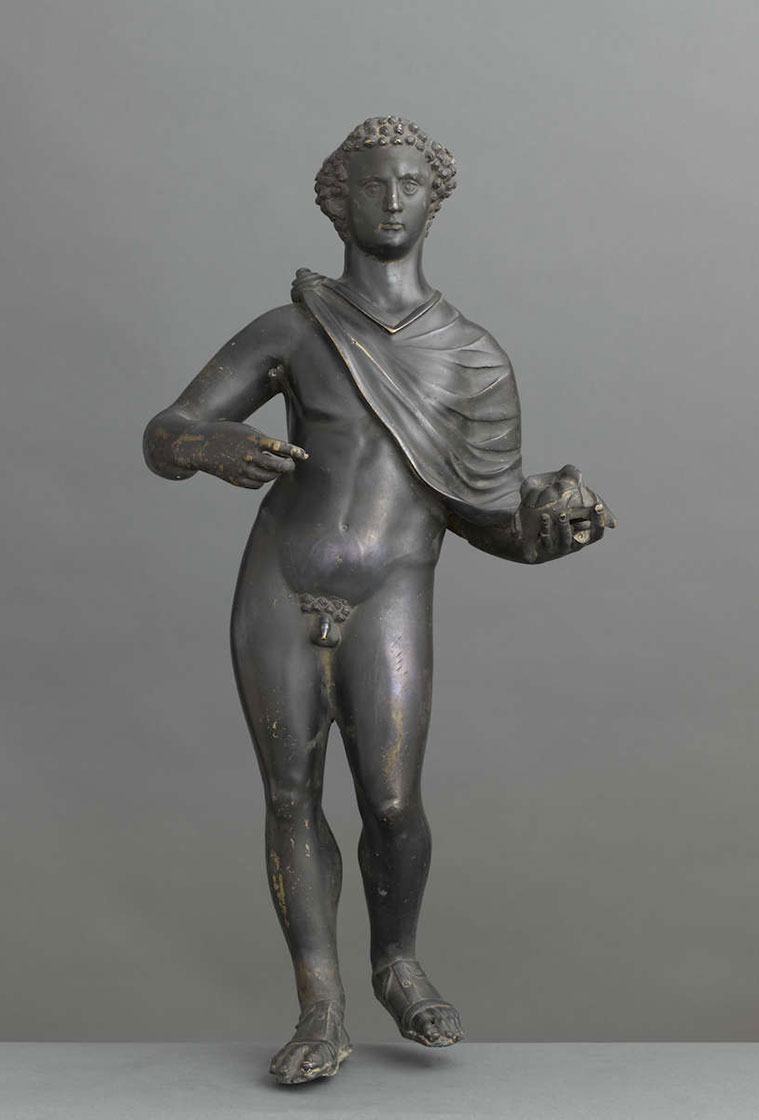
The phenomenon of ritual depositions of all sorts is well documented by archaeological finds, although we do not yet know much about the rules governing such practices. Though there are few written sources dealing with this topic on a theoretical level, in the last few years it has received increased attention.19 In any case it is to be assumed that there were no general regulations that applied to the whole range of depositions, from so-called ritual rubbish to intact statues, but rather that there were local traditions and interpretations, depending also on the type of objects to be deposited.20 Filling up a pit with a large quantity of small ceramics certainly followed different customs than did depositing statues or statuettes. Coming back to our topic, we do not know exactly how the statuettes from Turny and Thiennes were arranged when they were hidden, but we have more information about the way this was done in another case.
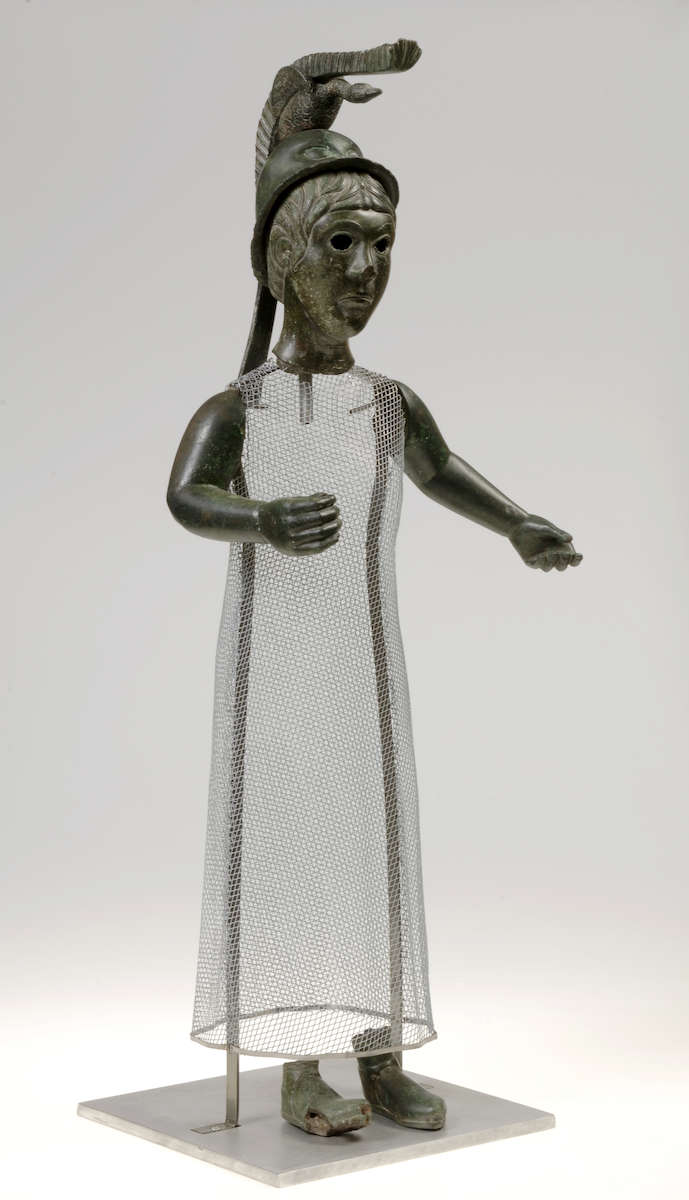
In 1913 (and in an additional attempt in 1928), a farmer at Kerguilly-en-Dinéault (Finistère, France), on the fringe of the Romanized parts of Gaul, discovered a large bronze statuette of Minerva (fig. 18.8), still standing upright in a pit carefully coated with clay.21 In the attempt to recover it, most of the body, consisting of a thin hammered sheet, crumbled away, and only the cast parts of the statuette survived. This combination of hammered and cast parts seems to have been typical of Gallo-Roman works of Early Imperial times and is evidenced by numerous other bronzes, for instance the famous masks and heads from the woods near La Compiègne (Oise, France), which also represent the closest stylistic parallels.22 In addition, there is a marked discrepancy in the proportions of the head and the limbs. There can be no doubt, however, that the statuette is directly derived from Roman, Classical-influenced representations of Minerva, as can be seen, for instance, in the crouching bird (a wild goose?) under the crest of the helmet, which seems to be a local adaptation of Minerva’s owl. Lacking any further information, we do not know why the statuette was “buried” in such a strange manner. We may safely assume that it had been an important votive object in a local sanctuary, or possibly even the main cult statue.
So far we have been looking at large statuettes stored away in isolation, without their bases and with no other objects; in these cases it was the location and the method of deposition that hinted at their previous use in the area of a sanctuary. Yet there are some deposits that contain a large variety of votive objects in addition to statuettes, many of them featuring votive inscriptions.
Certainly the largest and most precious temple treasure including statuettes is the silver hoard found at Berthouville (Eure, France) in 1830.23 It is linked to the deposit from Dalheim insofar as, according to the excavation reports of the late nineteenth century, its findspot, too, was located within the area of a large sanctuary. All the objects, which were deposited together at one stage, are of silver, indicating a deliberate prior separation of materials; accordingly, it can be assumed that a much larger quantity of bronze votive objects once existed. The votive inscriptions mention the names of nineteen dedicants who donated their small or larger offerings to the Gallo-Roman god Mercurius Canetonnensis.24 As the bases of the two statuettes of Mercury are lost,25 we do not have any information about their donors. Both figures were made by combining hammered and cast parts, the same technique used for the Minerva from Kerguilly. The two solid-cast hands of the larger statuette seem disproportionately small compared with the dominant head, which originally was covered with a separately cast petasos. The smaller Mercury, found in fragments, was reassembled and completed by a nineteenth-century artist. Both statuettes, made presumably at the end of the second or the beginning of the third century AD, may have been offered as votive objects to Mercury; there is no evidence linking the larger one with the cult statue itself, as has been tentatively suggested.26
The last statuette in this series, too, served as a votive object. It belongs to a bronze hoard (some of which is kept at the Getty Villa), whose origin could be ascertained, thanks to epigraphic evidence, as the territory of the Haedui (modern Burgundy, near Vézelay).27 There are in fact three statuettes depicting the previously unknown Gallo-Roman god Cobannus, but the two smaller ones adopt the well-known type of a young naked Mars whereas the largest statuette (nearly 70 cm or 27 ½ in. high) and artistically quite outstanding, presents an exceptional iconography.28 The god wears a Classical chlamys, normally worn by Mercury, over a long-sleeved tunic and long pants—a combination of garments also found in a few other statuettes of Gallo-Roman origin, such as those portraying Sucellus.29 His head, covered with a helmet of the “Niederbieber type” used by the Roman army in the second century AD, presents a sharp contrast to his peaceful outfit. We may safely assume that such an original creation could not have been bought ready-made but points to the initiative of its donor, L. Maccius Aeternus, himself a Roman citizen and magistrate, who made sure that he fulfilled his vow to this local god with an adequate gift.
This brief overview has shown that the group of medium-sized statuettes might greatly profit from more systematic research into their iconographic, technical, and functional aspects.
Notes
- In memory of Kenneth Painter († 13th May 2016). For a number of years I have been able to rely on him as an extremely kind and knowledgeable colleague who was very generous with his time. His demise has left us all bereft. ↩
- What had to be left aside in this paper are all the technological aspects that, however, might add much to a better understanding of the composition, manufacturing, and provenience of medium-sized statuettes. One successful step toward this target has been made with the exemplary study of the bronze hoard from Vieil-Evreux (Eure, France), which comprises two medium-sized statuettes; Azéma et al. 2012; Guyard et al. 2012. ↩
- Stewart 2003, 184–222, esp. 184–95; Estienne 2010; Estienne 2013. ↩
- Stewart 2003, 230–31; Kunze 2015, 58–9. ↩
- Kapossy 1969 seems still to be the only comprehensive study on the subject. ↩
- Heilmeyer 1996, 40–45; Peltz and Schalles 2011, 88–92. ↩
- H: 144 cm (56 ¾ in.). Hiller 1994; Peltz and Schalles 2011. ↩
- Reinach 1898; Oehmke 2004, 106, no. 51; Peltz and Schalles 2011, 92–94, fig. 9. ↩
- H: 67 cm (26 ⅜ in.). Oehmke 2004, 102, no. 47; Peltz and Schalles 2011, 92–94, fig 10. ↩
- H: 60 cm (23 ⅝ in.). Billoret 1970, 281, fig. 3; Manfrini-Aragno 1987, 62–63, fig. 46; Kaufmann-Heinimann 1998, 243, GF22, fig. 195. ↩
- Jupiter: de Ridder 1913, no. 36, pl. 7; Menzel 1980; Lavagne 1989, 29–30, no. 6 (F. Beck). Minerva (h: 40.2 cm or 15 ⅞ in.): de Ridder 1913, no. 1071, plate 63; Lavagne 1989, 28–29, no. 5 (F. Beck); Dövener 2010, 50–53, fig. 5. For the discovery and early excavations: Metzler and Zimmer 1978, 354–59, figs. 1–5. ↩
- Scheid 2007, 482. A complete but smaller bronze group of Jupiter, Juno, and Minerva (h: 29–33 cm or 11 ½–13 in.) was part of a hoard connected to a rural sanctuary at Muri (Switzerland): Leibundgut 1980, nos. 6, 42–43, plates 11–13, 54–59; Kaufmann-Heinimann 1998, 283, GF80, fig. 245. For other representations of the Capitoline triad, see Costantini 1997. ↩
- The actual state of the epigraphical evidence at Dalheim is presented by Krier 2011. ↩
- Deyts and Vernou 2008–2009. For representations of Rosmerta, see Bauchhenß 1994. ↩
- De Mély 1913; Boucher 1972. ↩
- It has to be noted that the metal composition analyzed in 1972 is not homogeneous; see Boucher 1972, 147–48. ↩
- Boucher 1972, 144–46, and accordingly Gury 2006, 110–11. A votive inscription from Geneva, now lost (CIL XII 2589), is still the only testimony known so far to mention Mars, Jupiter, and Mercury; see Bertrandy et al. 2005, 215–16, no. 824 (F. Wiblé). ↩
- As mentioned above, Roman sanctuaries usually housed all sorts of images besides the main cult statue; see, for example, W. Van Andringa’s instructive case study on the inventories of various temples in the center of Pompeii (Van Andringa 2012). ↩
- See Schäfer and Witteyer 2013; Scheid 2009; Scheid 2013. ↩
- See Haynes 2013 and the references given there. ↩
- Sanquer 1973; Galliou 2010, 184–85, fig. 142. ↩
- Woimant 1995, 287, fig. 185; Sanquer 1973, 75, figs. 9a–b. ↩
- Babelon 1916; Lapatin 2014. ↩
- Nuber 1974; Deniaux 2006. ↩
- H: 56.3 and 40.5 cm (22 ¼ and 16 in.). Babelon 1916, pls. 1–4; Lapatin 2014, figs. 6–7. ↩
- Baratte and Painter 1989, no. 27 (A. Kaufmann-Heinimann); Lapatin 2014, 17. ↩
- Pollini 2002; Rolley 2002, 281–87; Dondin-Payre and Kaufmann-Heinimann 2009. There are still some open questions concerning the original size and provenance of the hoard. ↩
- H: 67.5, 51.5, and 16 cm (36 ½, 20 ¼, and 6 ¼ in.). Pollini 2002, 7–12, nos. 4–6, figs. 27–54. ↩
- Kaufmann-Heinimann 2012, 5–18, figs. 3, 6–9, 12–13. ↩
Bibliography
- Azéma et al. 2012
- Azéma, A., B. Mille, F. Pilon, J.-C. Birolleau, and L. Guyard. 2012. “Étude archéométallurgique du dépôt de grands bronzes du sanctuaire gallo-romain du Vieil-Evreux (Eure).” ArchéoSciences 36: 153–72.
- Babelon 1916
- Babelon, E. 1916. Le trésor d’argenterie de Berthouville, près Bernay (Eure), conservé au Département des médailles et antiques de la Bibliothèque nationale. Paris: Librairie centrale des Beaux-Arts; Émile Lévy.
- Baratte and Painter 1989
- Baratte, F., and K. Painter, eds. 1989. Trésors d’orfèvrerie gallo-romains. Paris: Éditions de la Réunion des musées nationaux.
- Bauchhenß 1994
- Bauchhenß, G. 1994. “Rosmerta.” In LIMC 7: 644–48.
- Bertrandy et al. 2005
- Bertrandy, F., F. Kayser, A. Pelletier, B. Rémy, and F. Wiblé. 2005. Inscriptions latines de Narbonnaise (ILN). Vol. 5.3: Vienne. Gallia, Suppl. 44. Paris: CNRS.
- Billoret 1970
- Billoret, R. 1970. “Circonscription de Lorraine.” Gallia 70: 281–315.
- Boucher 1972
- Boucher, S. 1972. “Trois bronzes divins de Thiennes (Nord).” Gallia 30: 127–48.
- Costantini 1997
- Costantini, A. 1997. “La Triade Capitolina.” In LIMC 8: 461–70.
- Deniaux 2006
- Deniaux, E. 2006. “Les dédicants du trésor du sanctuaire de Berthouville (cité des Lexonii).” In Sanctuaires, pratiques cultuelles et territoires civiques dans l’Occident romain, ed. M. Dondin-Payre and M.-Th. Raepsaet-Charlier, 271–95. Brussels: Livre Timperman.
- Deyts and Vernou 2008–2009
- Deyts, S., and C. Vernou. 2008–2009. “Mercure et Rosmerta, un nouveau couple de divinités gallo-romaines au Musée archéologique.” Bulletin des Musées de Dijon 11: 23–33.
- Dondin-Payre and Kaufmann-Heinimann 2009
- Dondin-Payre, M., and A. Kaufmann-Heinimann. 2009. “Trésors et biens des temples: Réflexions à partir de cas de Gaules: Neuvy: Champoulet, Cobannus (Éduens).” Archiv für Religionsgeschichte 11: 89–120.
- Dövener 2010
- Dövener, F. 2010. “‘Auge um Auge’ … Ein seltenes Fundstück aus dem Tempelbezirk des römischen Vicus in Dalheim.” Empreintes 3: 48–53.
- Estienne 2010
- Estienne, S. 2010. “Simulacra deorum versus ornamenta aedium: The Status of Divine Images in the Temples of Rome.” In Divine Images and Human Imaginations in Ancient Greece and Rome, ed. J. Mylonopoulos, 259–71. Religions in the Graeco-Roman World 170. Leiden: Brill.
- Estienne 2013
- Estienne, S. 2013. “Penser le patrimoine des dieux, entre public et privé.” In Dialogues entre sphère publique et sphère privée dans l’espace de la cité romaine: Vecteurs, acteurs, significations, ed. A. Dardenay and E. Rosso, 55–66. Ausonius Éditions, Scripta Antiqua 56. Bordeaux: De Boccard.
- Galliou 2010
- Galliou, P. 2010. Carte archéologique de la Gaule. 29: Le Finistère. Paris: Académie des Inscriptions et Belles-Lettres.
- Gury 2006
- Gury, F. 2006. “Mars en Gaule romaine: images d’un dieu investi par l’idéologie impériale.” In Mars en Occident: Actes du colloque international “Autour d’Allones (Sarthe), les sanctuaires de Mars en Occident,” Le Mans, Université du Maine, 4–5–6 juin 2003, ed. F. Brouquier-Reddé, E. Betrand, M.-B. Chardenoux, K. Gruel, and M.-C. L’Huillier, 105–19. Rennes: Presses Universitaires.
- Guyard et al. 2012
- Guyard, L., C. Fontaine, and S. Bertaudière. 2012. “Relecture du dépôt de bronze de l’époque romaine du Vieil-Évreux (Eure).” Gallia 69.2: 151–94.
- Haynes 2013
- Haynes, I. 2013. “Advancing the Systematic Study of Ritual Deposition in the Greco-Roman World.” In Schäfer and Witteyer 2013, 7–19.
- Heilmeyer 1996
- Heilmeyer, W.-D. 1996. Der Jüngling von Salamis: Technische Untersuchungen zu römischen Großbronzen. Mainz: Philipp von Zabern.
- Hiller 1994
- Hiller, H. 1994. “Zum Xantener Bronzeknaben.” In Akten der 10. Internationalen Tagung über antike Bronzen, Freiburg, 18.–22. Juli 1988, 201–10. Forschungen und Berichte zur Vor- und Frühgeschichte in Baden-Württemberg 45.
- Kapossy 1969
- Kapossy, B. 1969. Brunnenfiguren der hellenistischen und römischen Zeit. Zurich: Juris Druck & Verlag.
- Kaufmann-Heinimann 1998
- Kaufmann-Heinimann, A. 1998. Götter und Lararien aus Augusta Raurica: Herstellung, Fundzusammenhänge und sakrale Funktion figürlicher Bronzen in einer römischen Stadt. Forschungen in Augst 26. Augst: Römermuseum.
- Kaufmann-Heinimann 2012
- Kaufmann-Heinimann, A. 2012. “Ikonographie und Stil: Zu Tracht und Ausstattung einheimischer Gottheiten in den Nordwestprovinzen.” In Bronzes grecs et romains: Hommage à Claude Rolley, 2–28. Institut national d’historie de l’art (INHA), Actes de colloques & livres en ligne. http://inha.revues.org/7253.
- Krier 2011
- Krier, J. 2011. “Deae Fortunae ob salutem imperi: Nouvelles inscriptions de Dalheim (Luxembourg) et la vie religieuse d’un vicus du nord-est de la Gaule à la veille de la tourmente du IIIe siècle.” Gallia 68.2: 313–40.
- Kunze 2015
- Kunze, C. 2015. “Kontextwechsel: Zur Interpretation antiker Skulpturen in unterschiedlichen Aufstellungssituationen.” In Leibhafte Kunst: Statuen und kulturelle Identität, ed. D. Boschung and C. Vorster, 55–91. Morphomata 24. Paderborn: Wilhelm Fink.
- Lapatin 2014
- Lapatin K., ed. 2014. The Berthouville Silver Treasure and Roman Luxury. Los Angeles: J. Paul Getty Museum.
- Lavagne 1989
- Lavagne, H., ed. 1989. Les dieux de la Gaule romaine. Exh. cat. Luxembourg, Galerie d’Art Municipale Villa Vauban. Luxembourg: Ville de Luxembourg.
- Leibundgut 1980
- Leibundgut, A. 1980. Die römischen Bronzen der Schweiz. Vol. 3: Westschweiz, Bern und Wallis. Mainz: Philipp von Zabern.
- Manfrini-Aragno 1987
- Manfrini-Aragno, I. 1987. Bacchus dans les bronzes hellénistiques et romains: Les artisans et leur répertoire. Cahiers d’archéologie romande 34. Lausanne: Bibliothèque historique vaudoise.
- de Mély 1913
- de Mély, E. 1913. “Les trois statuettes de bronze de Merville.” MonPiot 20: 155–62.
- Menzel 1980
- Menzel, H. 1980. “Die Jupiterstatuetten von Bree, Evreux und Dalheim und verwandte Bronzen.” In Toreutik und figürliche Bronzen römischer Zeit: Akten der 6. Tagung über antike Bronzen, 13.–17. Mai 1980 in Berlin, ed. U. Gehrig, 186–96. Berlin: Staatliche Museen Preussischer Kulturbesitz.
- Metzler and Zimmer 1978
- Metzler, J., and J. Zimmer. 1978. “Beiträge zur Archäologie von Dalheim.” Hémecht 30: 351–82.
- Nuber 1974
- Nuber, H. U. 1974. “Zum Vergrabungszeitpunkt der Silberfunde von Hildesheim und Berthouville.” BMusBrux 46: 23–30.
- Oehmke 2004
- Oehmke, S. 2004. Das Weib im Manne: Hermaphroditos in der griechisch-römischen Antike. Winckelmann-Institut der Humboldt-Universität zu Berlin 4. Berlin: Willmuth Arenhövel.
- Peltz and Schalles 2011
- Peltz, U., and H.-J. Schalles. 2011. Der Xantener Knabe: Technologie, Ikonographie, Funktion und Datierung. Xantener Berichte: Grabung – Forschung – Präsentation 22. Darmstadt and Mainz: Philipp von Zabern.
- Pollini 2002
- Pollini, J. 2002. Gallo-Roman Bronzes and the Process of Romanization: The Cobannus Hoard. Monumenta Graeca et Romana 9. Leiden, Boston, and Cologne: Brill.
- Reinach 1898
- Reinach, S. 1898. “Hermaphrodite: Statuette de bronze de la collection du Mis de Luppé.” RA: 321–36.
- de Ridder 1913
- de Ridder, A. 1913. Les bronzes antiques du Louvre. Vol. 1: Les figurines. Paris: Ernest Leroux.
- Rolley 2002
- Rolley, C. 2002. “Les bronzes grecs et romains: recherches récentes.” RA: 269–89.
- Sanquer 1973
- Sanquer, R. 1973. “La grande statuette de bronze de Kerguilly en Dinéault (Finistère).” Gallia 31: 61–80.
- Schäfer and Witteyer 2013
- Schäfer, A., and M. Witteyer, eds. 2013. Rituelle Deponierungen in Heiligtümern der hellenistisch-römischen Welt: Internationale Tagung Mainz 28.–30. April 2008. Mainzer Archäologische Schriften 10. Mainz: Generaldirektion Kulturelles Erbe, Direktion Landesarchäologie.
- Scheid 2007
- Scheid, J. 2007. “Comprendre les cultes et lieux de culte des cités des Gaules.” In Les villes romaines du Nord de la Gaule: Vingt ans de recherches nouvelles: Actes du XXVe colloque international de HALMA-IPEL UMR CNRS 8164, ed. R. Hanoune, 477–83. Revue du Nord, hors série. Collection Art et Archéologie 10. Villeneuve-dAscq: Revue du Nord.
- Scheid 2009
- Scheid, J. 2009. “Les biens des temples à Rome et dans le monde romain.” Archiv für Religionsgeschichte 11: 1–4.
- Scheid 2013
- Scheid, J. 2013. “Bemerkungen zu bothros und fauis(s)a.” In Schäfer and Witteyer 2013, 21–24.
- Stewart 2003
- Stewart, P. 2003. Statues in Roman Society: Representation and Response. Oxford: Oxford University Press.
- Van Andringa 2012
- Van Andringa, W. 2012. “Statues in the Temples of Pompeii: Combinations of Gods, Local Definitions of Cults, and the Memory of the City.” In Historical and Religious Memory in the Ancient World, ed. B. Dignas and R. R. R. Smith, 83–115. Oxford: Oxford University Press.
- Woimant 1995
- Woimant, G.-P. 1995. Carte archéologique de la Gaule. 60: L‘Oise. Paris: Académie des Inscriptions et Belles-Lettres.